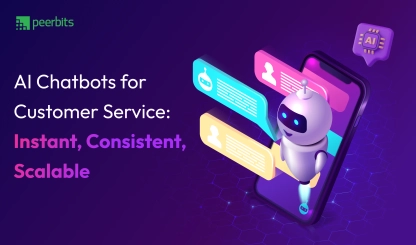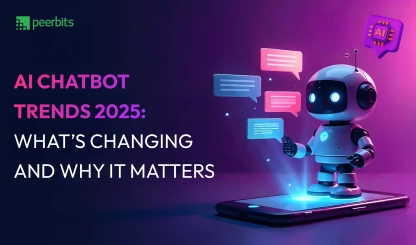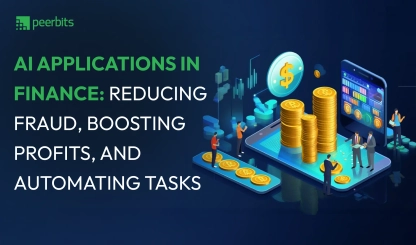AI chatbots are quickly becoming a regular fixture across websites, apps, and enterprise systems. Whether it’s handling support tickets, collecting feedback, or guiding users through workflows, they promise round-the-clock efficiency without adding headcount.
And companies are buying in.
As per Mordor Intelligence, the chatbot market is projected to reach $8.71 billion by 2025 and grow to $25.88 billion by 2030, with a CAGR of 24.32%. That kind of growth reflects real budgets and expectations, so it is not just hype.
But while interest is high, successful implementation often tells a different story.
Many businesses jump excitedly but soon hit unexpected friction. Some struggle with AI chatbot integration, while others face issues like tools that sound robotic, confuse users, or break when integrated into complex systems.
Even teams who already have functional AI chatbots may notice that adoption is low, flows are clunky, or internal resources are stretched thin just trying to maintain it.
Maybe that’s exactly where you are right now.
Building, fixing, or about to launch your chatbot, wondering what could go wrong or how to get it right.
Let's explore the top 10 challenges in AI chatbot implementation and scaling, with proven fixes for each.
#1 Misunderstanding nature of AI chatbot systems
Many AI chatbot challenges begin with early misconceptions. Teams often underestimate what's required to build and maintain a reliable, intelligent system.
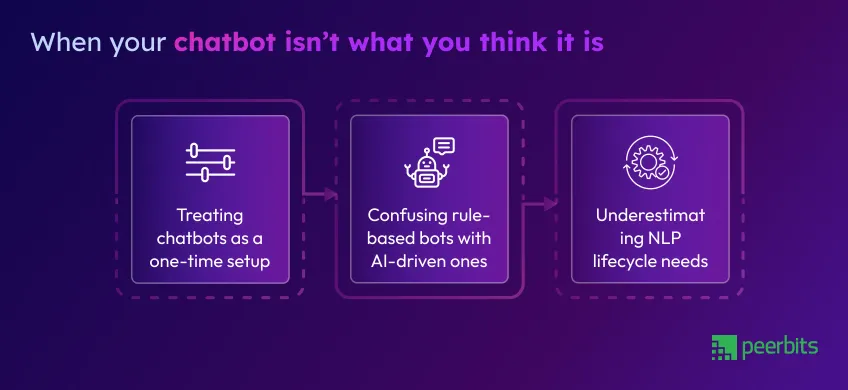
Treating chatbots as a one-time setup
Challenge:
Many teams treat AI chatbots like a one-and-done project. They launch, move on, and assume the bot will just keep working. But static systems lead to outdated responses, missed queries, and an overall drop in user trust.
Solution:
AI chatbot development isn’t a “set and forget” job. It needs consistent tuning. Set up a regular feedback loop to improve response accuracy, identify chatbot conversation flow gaps, and refine the model using updated chatbot training data. A reliable AI Chatbot development service can easily offer maintenance, helping you overcome AI chatbot issues early on.
Confusing rule-based bots with AI-driven ones
Challenge:
Some teams install a bot expecting human-like replies, only to discover it can’t handle anything outside its script. That’s usually because it’s rule-based, not AI-powered. And this confusion sets the stage for failed expectations.
Solution:
Rule-based bots are limited to predefined flows. If you're aiming for smarter conversations and broader use cases, AI-driven chatbots with NLP are the right path. But they come with their own setup needs, including NLP lifecycle management, intent classification, and continuous training. Knowing the difference helps avoid some common AI chatbot issues.
Read more: AI Chatbots & their Types Explained
Underestimating NLP lifecycle needs
Challenge:
One of the most overlooked AI chatbot problems is neglecting the NLP lifecycle. Businesses feed the system some initial data and leave it untouched. Over time, accuracy falls, and the chatbot struggles to understand even routine inputs.
Solution:
Strong NLP means ongoing training, evaluation, and tuning. Build processes for regular model reviews, monitor AI chatbot integration issues, and keep training data accurate and diverse. A healthy NLP lifecycle is key to delivering consistent AI chatbot user experiences.
#2 Unstructured or incomplete conversation design
Poor conversation flow leads to confused users and high drop-offs. AI chatbots need carefully mapped flows that match real user goals and handle unexpected inputs smoothly.
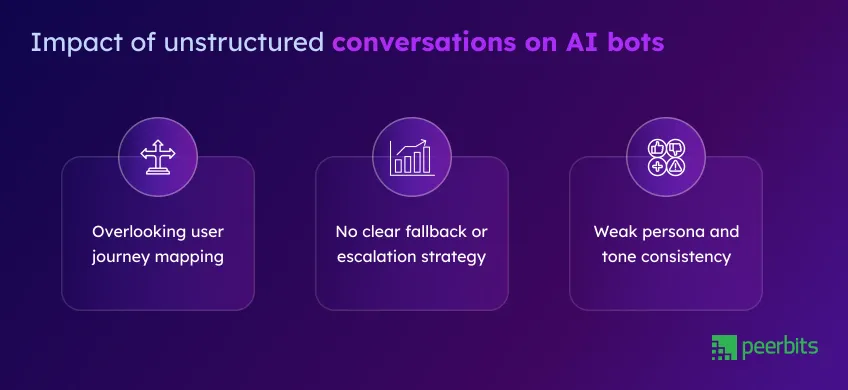
Overlooking user journey mapping
Challenge:
When user journeys are overlooked, bots may not meet user expectations. Without mapping out common scenarios, AI chatbots can fail to provide relevant answers or guide users effectively.
Solution:
Design your chatbot with user journey mapping in mind. Account for all key interactions, including potential friction points, and ensure the bot’s responses align with each stage of the journey.
No clear fallback or escalation strategy
Challenge:
Without fallback strategies, users are left stranded when a chatbot doesn’t understand their input. This leads to frustration and a negative AI chatbot user experience, especially when the bot doesn’t escalate to a human.
Solution:
Implement fallback responses for when the chatbot doesn’t understand, and always have a clear AI chatbot escalation path to human agents. This ensures users can get the help they need without frustration.
Weak persona and tone consistency
Challenge:
Bots with inconsistent personas or tone of voice can confuse users. Switching from formal to casual tones or lacking a clear personality diminishes trust and makes interactions feel robotic, causing AI chatbot user trust issues.
Solution:
Establish a consistent tone and persona that matches your brand voice. Ensure every interaction feels genuine and coherent, which will improve user engagement and build trust in your AI chatbot solution.
#3 Backend integration issues & data access barriers
A chatbot’s efficiency heavily relies on smooth backend integration. When data access is blocked, or systems don’t sync properly, it can lead to slow response times, errors, and poor user experiences.
Chatbots that only reply, not act
Challenge:
Many chatbots are limited to merely replying to user queries. However, in today’s fast-paced environment, bots need to take action like completing tasks or fetching data to truly enhance the user experience. Without this ability, chatbots become little more than a virtual assistant without real utility.
Solution:
Build bots that not only reply but also act on requests. Integrating with your backend systems ensures chatbots can complete tasks, trigger actions, or fetch real-time data. This turns your chatbot into a proactive assistant that adds significant value to customer interactions.
API blockers and legacy systems
Challenge:
When trying to connect chatbots to older systems or APIs, issues often arise due to outdated technology or incompatible protocols. Legacy systems can block seamless integration, preventing the chatbot from accessing critical data and features.
Solution:
Assess and upgrade legacy systems through expert AI consulting services to ensure compatibility with modern chatbot platforms. When needed, utilise middleware solutions or API adapters that bridge the gap between outdated infrastructure and new technologies, enabling smooth AI chatbot integration.
Inconsistent data sources
Challenge:
Chatbots relying on multiple, inconsistent data sources may provide inaccurate or contradictory answers. If the data isn’t synchronized or updated across platforms, it leads to confusion and a fragmented user experience.
Solution:
Consolidate data sources into a unified system, ensuring consistent, reliable access to information. Regularly update the data across all platforms to maintain accuracy and provide users with correct, up-to-date answers, improving your AI chatbot solution.

#4 Unrealistic goals and misaligned expectations
Too often, AI chatbot projects start with excitement but no clear boundaries. When expectations don't match reality, teams end up chasing results that the bot just isn't built to deliver.
Setting your sights too high too soon
Challenge:
Some teams expect their AI chatbot to handle every conversation from day one. This pressure leads to rushed deployments, incomplete training, and frustrated users when the chatbot underperforms.
Solution:
Start with focused, high-impact use cases like FAQs or support queries. Scale gradually while tracking performance. This step-by-step rollout lets your AI chatbot solution mature without overwhelming your team or your users.
Undefined metrics for success
Challenge:
Launching a chatbot without defining what success looks like makes it hard to measure impact. Teams often rely on vague indicators instead of tracking real business outcomes or user satisfaction.
Solution:
Set clear KPIs response time, resolution rate, handoff rate, or CSAT scores. Measuring the chatbot’s performance against actual business goals helps you improve continuously and justify the investment in your AI chatbot integration.
Trying to replace humans too early
Challenge:
Expecting a chatbot to fully replace human agents too soon can damage customer experience. Bots may fail in complex conversations, leading to unresolved issues and negative feedback.
Solution:
Use the chatbot to assist, not replace. Automate repetitive tasks while keeping a clear path for human escalation. This hybrid setup keeps users happy and your AI chatbot system running smoothly.
#5 Data preparation and model training struggles
Training an AI chatbot isn’t just about feeding it data. It’s about feeding it the right data, in the right way. Many teams struggle with model quality because they skip foundational work.
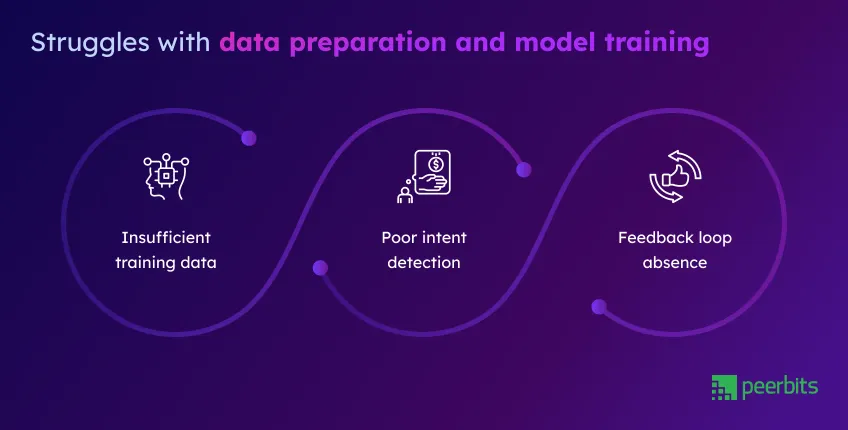
Insufficient training data
Challenge:
Without enough varied user queries, your AI chatbot can’t recognize patterns or respond accurately. It ends up missing common intents or confusing simple questions.
Solution:
Start with real user chat logs, support tickets, or FAQs. Continuously expand your dataset as users interact. A strong data foundation helps your AI chatbot deliver more reliable and contextual responses.
Poor intent detection
Challenge:
If your bot misinterprets what users mean, the conversation stalls. This often happens when intents are too broad, too similar, or poorly mapped to actions.
Solution:
Break intents into specific use cases with clearly defined training examples. Fine-tune them through regular NLP evaluations. This clarity improves your AI chatbot system’s accuracy and response confidence.
Feedback loop absence
Challenge:
AI chatbots that aren’t learning from past mistakes become stale fast. If there’s no system to track and retrain based on user behavior, errors keep repeating.
Solution:
Implement a feedback loop using chat transcripts and failed interactions. Feed this into your NLP pipeline regularly. Continuous learning keeps your AI chatbot solution sharp and aligned with real-world use.
#6 Trust, privacy, and user control
Even the smartest AI chatbot can fall flat if users don’t trust it. Building trust means being transparent, respectful of privacy, and ready to hand control back to the user when needed.
Lack of transparency
Challenge:
If users aren’t sure whether they’re talking to a bot or a human, or what data is being used, they’re less likely to engage. Hidden automation creates distrust.
Solution:
Make your AI chatbot explain its role clearly from the start. Let users know what it can do and when a human might step in. Clear disclosure builds user confidence in chatbot communication.
Privacy and compliance risks
Challenge:
Handling personal or sensitive data without clear boundaries can lead to compliance issues and user concerns. One slip could put customer trust at risk.
Solution:
Follow data privacy standards like GDPR or HIPAA based on your region. Train your AI chatbot system to mask or avoid storing sensitive data. Privacy-first design earns long-term trust.
No human fallback option
Challenge:
Bots can’t do everything. If users get stuck with no way to escalate, frustration rises. It’s a fast way to lose trust in your AI chatbot solution.
Solution:
Always offer a route to human support. This could be via live chat, callback requests, or ticketing handoff. Reliable fallback makes users feel heard, even when the AI hits a limit.
#7 Internal blockers: Organizational friction
Many AI chatbot projects struggle not because of tech, but due to internal misalignment. Lack of collaboration, unclear ownership, or vendor reliance can slow or derail progress entirely.
When teams don’t sync, chatbot efforts stall
Challenge:
Misalignment between product, tech, and CX teams leads to delays, overlapping efforts, or missed expectations. Silos create friction in chatbot development and adoption.
Solution:
Set up regular syncs across departments, and define shared goals early. Make AI chatbot implementation a cross-functional effort to avoid gaps in execution or user experience.
Without clear ownership, chatbots drift off course
Challenge:
No single owner often means no one’s really driving. Chatbot quality dips, updates are missed, and performance tracking becomes an afterthought.
Solution:
Assign dedicated chatbot product owners or teams. They should manage roadmap, training cycles, and AI chatbot integration with evolving business needs.
Vendor dependency and knowledge gaps
Challenge:
Relying heavily on external vendors without internal understanding creates bottlenecks. Small updates can take weeks, and long-term improvements slow down.
Solution:
Invest in internal training and build chatbot knowledge in-house. Even if vendors are involved, your team should control the AI chatbot strategy and scaling roadmap.
#8 Post-launch neglect: Long-term chatbot care
Launching your AI chatbot isn’t the finish line. Without ongoing updates, performance checks, or data refreshes, even the best bots start slipping fast.
No iteration plan after launch
Challenge:
Some teams launch and leave the chatbot untouched. User behaviors evolve, business needs change, and static bots quickly feel outdated or irrelevant.
Solution:
Create a clear post-launch roadmap. Schedule iteration cycles, review user feedback, and adjust AI chatbot flows regularly to match current demands.
Absence of performance monitoring
Challenge:
Without visibility into key chatbot metrics, issues go unnoticed. Drop-offs, repeated user complaints, or unanswered queries silently pile up.
Solution:
Set up real-time performance dashboards. Track AI chatbot response quality, task success rates, and user satisfaction to catch and fix problems early.
Stagnant training data
Challenge:
Chatbots trained once and left alone slowly lose accuracy. Outdated data makes NLP weaker, leading to missed intents or user frustration.
Solution:
Keep your training data fresh. Use conversation logs to retrain models, update intent libraries, and support long-term AI chatbot scalability and relevance.
#9 Cost overruns and unclear budgeting
AI chatbot projects often start with optimism but run into hidden expenses. Without clear budgeting and planning, teams either overspend or underinvest.
Hidden AI costs that catch teams off guard
Challenge:
Many overlook the full cost picture — from third-party APIs to storage, analytics, or scaling infrastructure. These surprises hit mid-way through the project.
Solution:
Create a detailed cost breakdown early on. Factor in recurring expenses like NLP processing, cloud usage, and AI chatbot integrations to stay on track.
Neglecting long-term maintenance costs
Challenge:
Ongoing support, content updates, training data refreshes, and tech support often don’t make it into initial budgets, leading to project fatigue.
Solution:
Plan for the full lifecycle. Budget monthly or quarterly for AI chatbot maintenance, retraining cycles, and updates aligned with business evolution.
Overengineering solutions
Challenge:
Some teams get carried away building complex flows or custom AI modules that don’t directly serve core user needs, driving up costs fast.
Solution:
Start simple. Focus on solving immediate problems first. Scale your AI chatbot with measured, user-driven improvements instead of over-designing.
#10 Moving toward sustainable success: The smart way forward
Treat your chatbot like a product, not a project. Long-term wins come from clarity, tracking, and knowing when to bring in the right help.
Think of chatbots as a living product
Challenge:
Many teams treat chatbot launch as the finish line. But without updates or iteration, the experience slowly breaks down.
Solution:
Set up regular review cycles. Keep content fresh, training data relevant, and flows updated to match how users interact over time.
Align chatbot goals with business objectives
Challenge:
Chatbots often exist in a vacuum, disconnected from wider company KPIs. That limits their value and support across teams.
Solution:
Tie chatbot use cases directly to customer support goals, lead gen targets, or sales pipeline support. Make success measurable and relevant.
Use analytics to keep improving
Challenge:
Without tracking key metrics like drop-off points, task completion, or user sentiment, teams fly blind post-launch.
Solution:
Use built-in analytics or third-party tools to track performance. Let real data guide decisions around NLP tuning or UX fixes.
Knowing when it’s time to call in chatbot specialists
Challenge:
In-house teams can hit a wall with design, NLP tuning, or integrations. Pushing forward without support often leads to wasted cycles.
Solution:
This is where AI development services help. Specialists can step in with domain expertise, proven frameworks, and tailored guidance to get things unstuck fast.
Conclusion
AI chatbots aren’t magical tools. As discussed above, they work best when businesses treat them as evolving systems that need planning, training, tuning, and care. Most chatbot failures trace back to a few overlooked patterns, rushing implementation, skipping alignment with goals, underestimating the lifecycle, or ignoring long-term upkeep.
Avoiding these pitfalls doesn’t require huge investments; just clarity and ownership can bring significant changes. Whether it's setting realistic goals, refining NLP models, or collaborating with teams offering AI chatbot development services, each small decision moves you closer to impactful results.
In the end, the smartest chatbot move isn’t about chasing trends. It’s about building something that fits your business, works for your users, and gets better with time.


